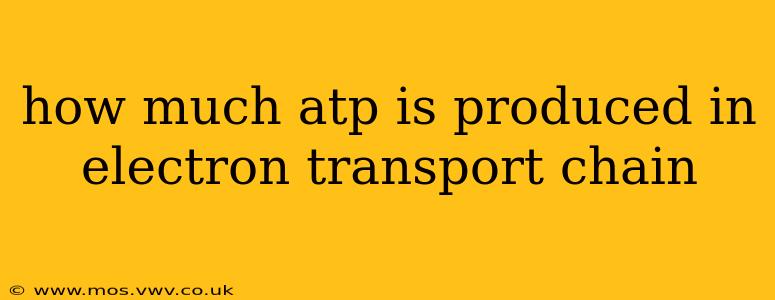How Much ATP is Produced in the Electron Transport Chain?
The electron transport chain (ETC), also known as the respiratory chain, is the final stage of cellular respiration. It's a crucial process that generates the vast majority of the ATP (adenosine triphosphate) – the cell's energy currency – used by our bodies. But precisely how much ATP is produced isn't a simple answer. The actual yield varies depending on several factors, making it a complex topic even for experts.
While textbooks often cite a figure of around 32-34 ATP molecules per glucose molecule, this is a simplified approximation. The true number is closer to 28-30 ATP molecules, and the variation stems from several key considerations:
1. The Proton Motive Force and ATP Synthase:
The ETC doesn't directly produce ATP. Instead, it establishes a proton gradient (a difference in the concentration of protons, or H+, across the inner mitochondrial membrane). This gradient stores potential energy, known as the proton motive force (PMF). This PMF then drives ATP synthesis through an enzyme called ATP synthase. The exact number of protons needed to synthesize one ATP molecule isn't fixed and varies depending on factors like the temperature and the efficiency of the system.
2. The Shuttle Systems and NADH/FADH2:
NADH and FADH2 are electron carriers that deliver electrons to the ETC. The number of ATP molecules produced from each depends on the shuttle system used to transport them into the mitochondria. The malate-aspartate shuttle produces more ATP from NADH than the glycerol-3-phosphate shuttle. These variations influence the overall ATP yield.
3. Energy Lost as Heat:
Some energy from the PMF is lost as heat during the process. This inefficiency further reduces the net ATP production.
How Many ATP Molecules are Produced from NADH and FADH2?
Often, simplified models suggest approximately 3 ATP per NADH and 2 ATP per FADH2. However, this is a simplification. A more realistic estimate would be:
- NADH: ~2.5 ATP per molecule.
- FADH2: ~1.5 ATP per molecule.
This discrepancy accounts for the energy lost during the process and the variable proton-to-ATP ratio.
What about the other stages of cellular respiration?
It's crucial to remember that the ETC isn't the only ATP-producing stage of cellular respiration. Glycolysis and the Krebs cycle also contribute:
- Glycolysis: Produces a net of 2 ATP molecules.
- Krebs Cycle: Produces 2 ATP molecules per glucose molecule.
Therefore, adding up the ATP from all stages, the total ATP production from a single glucose molecule through cellular respiration is closer to 28-30 ATP, with the ETC contributing the largest share.
Factors Affecting ATP Production:
Several factors can influence the exact amount of ATP produced:
- Temperature: Higher temperatures can increase the rate of electron transport but also lead to greater energy loss as heat.
- Oxygen Availability: The ETC requires oxygen as the final electron acceptor. Lower oxygen levels significantly reduce ATP production.
- Metabolic State of the Cell: The demand for ATP affects the efficiency of the ETC.
In conclusion, while the commonly cited figure of 32-34 ATP molecules is a useful approximation, a more accurate and nuanced understanding suggests a range of 28-30 ATP molecules produced per glucose molecule during cellular respiration, with the electron transport chain being the primary contributor. The precise yield is influenced by a range of factors, highlighting the complexity and dynamic nature of this fundamental biological process.
